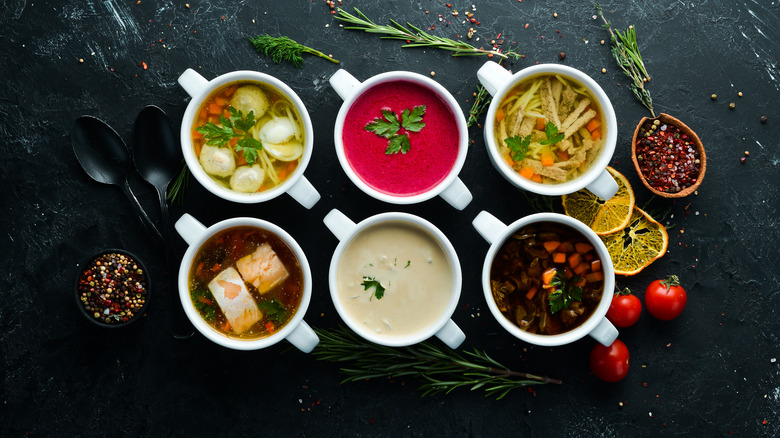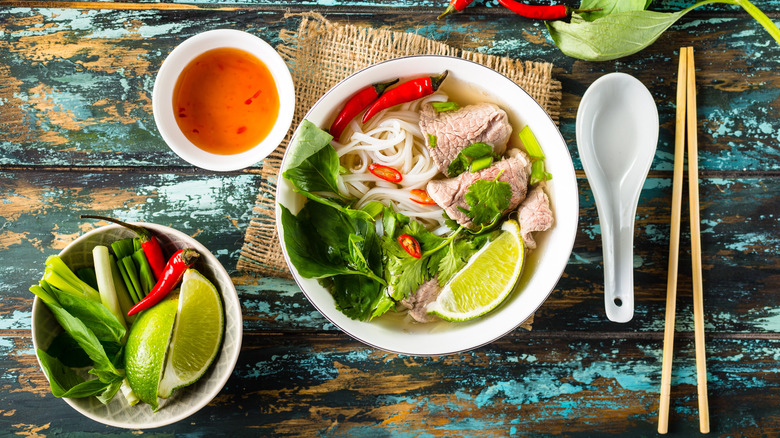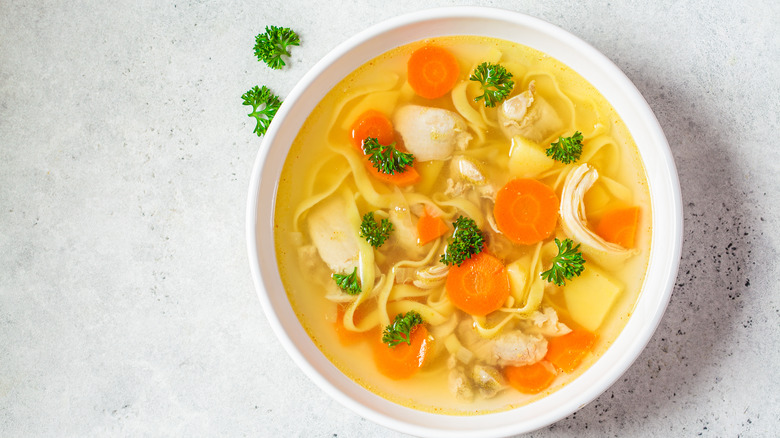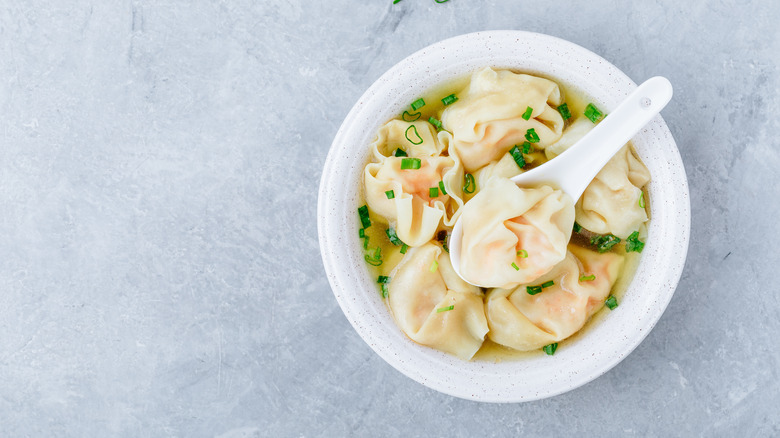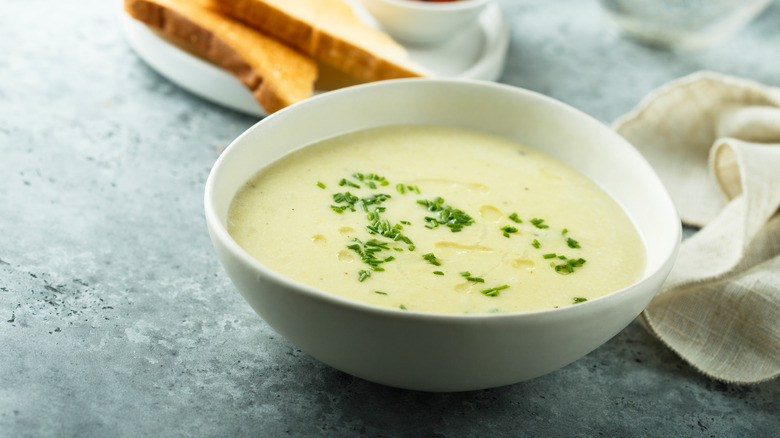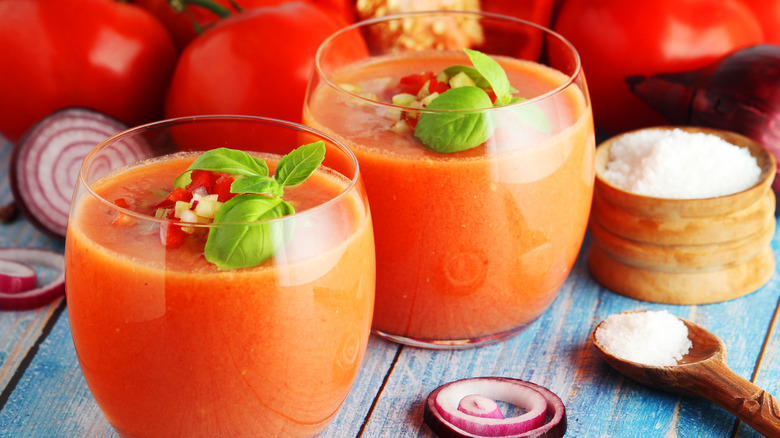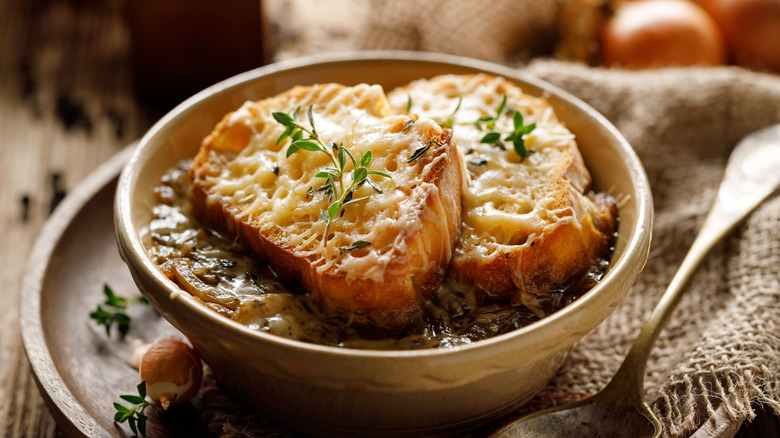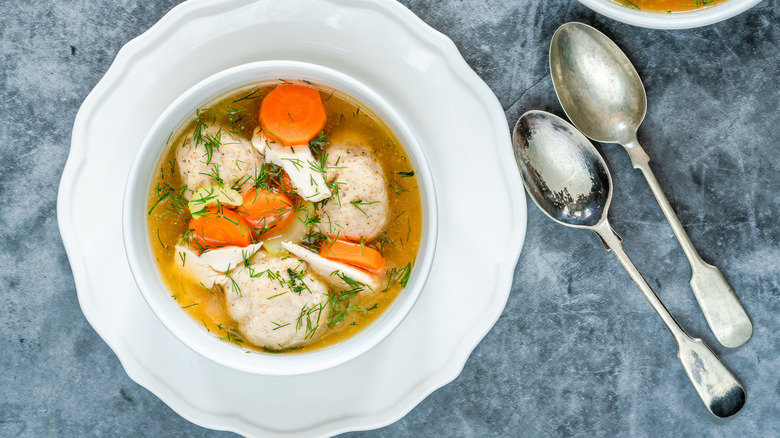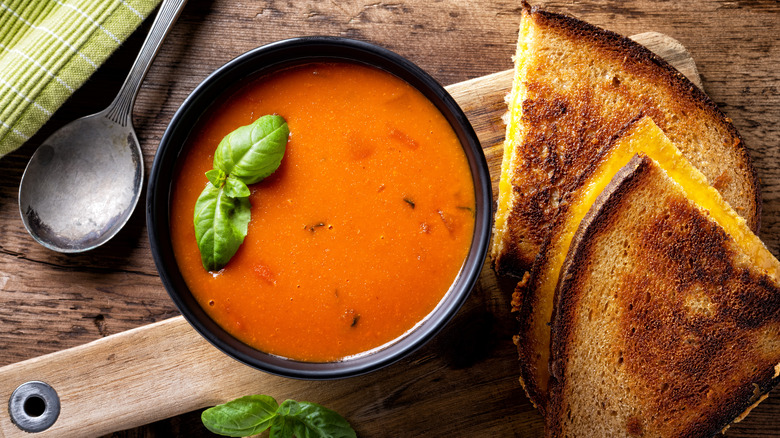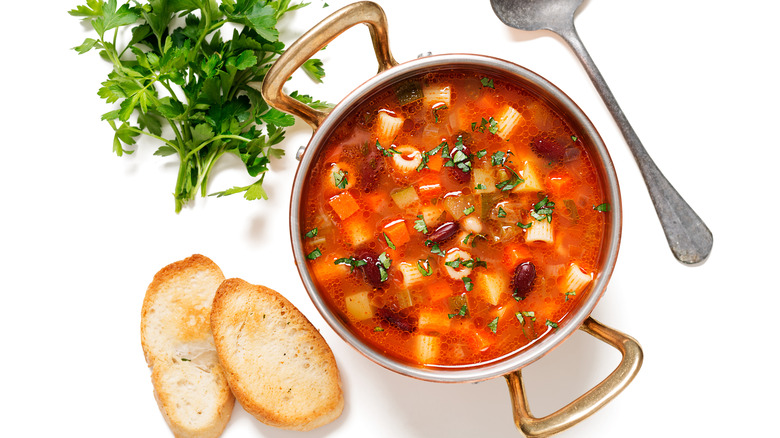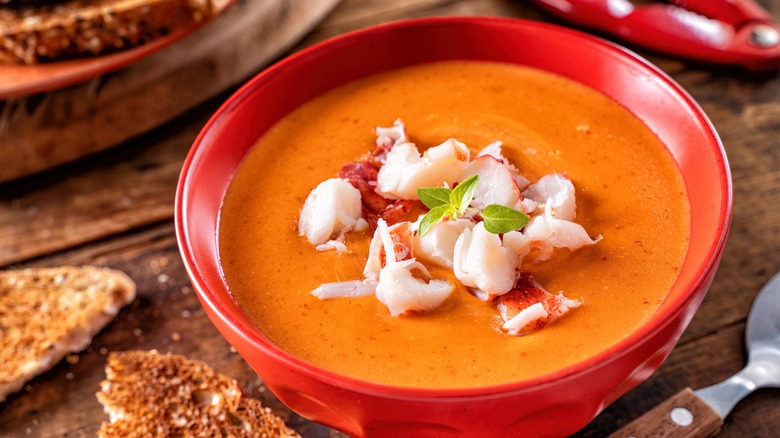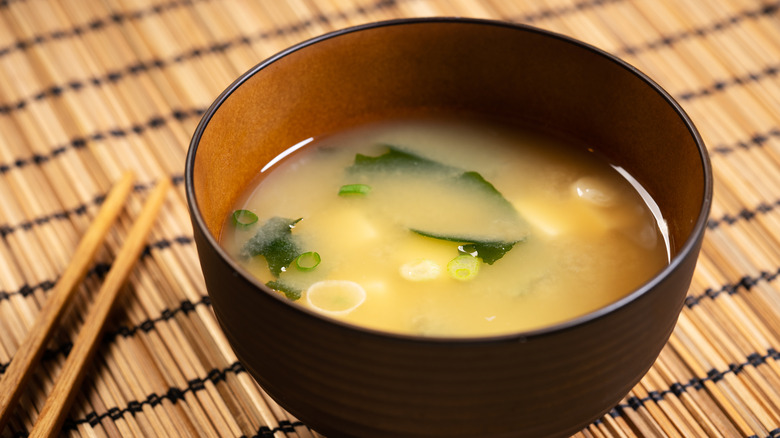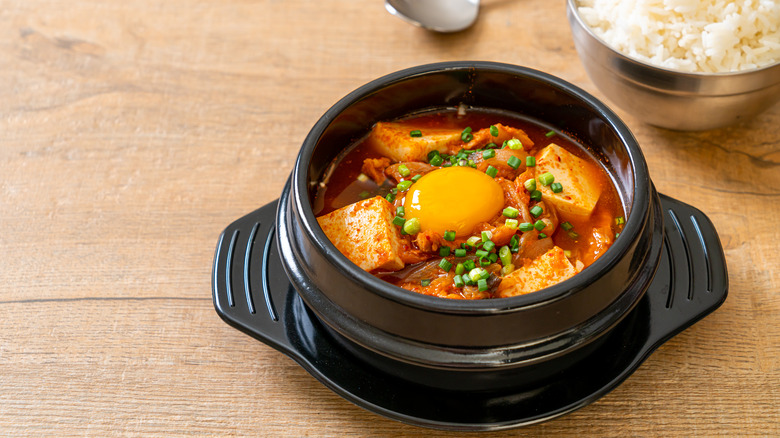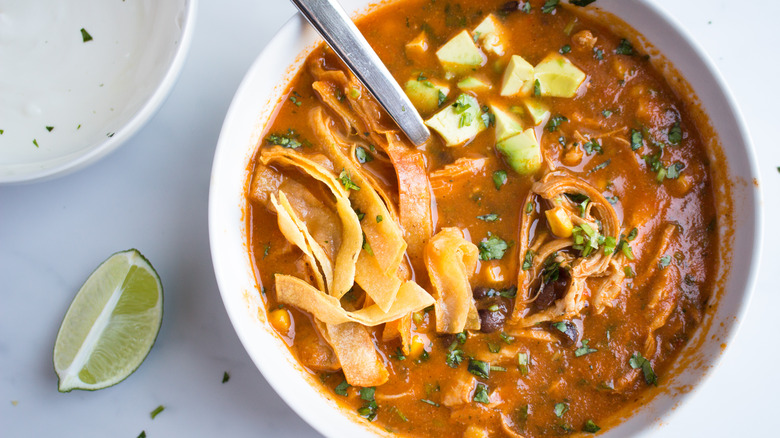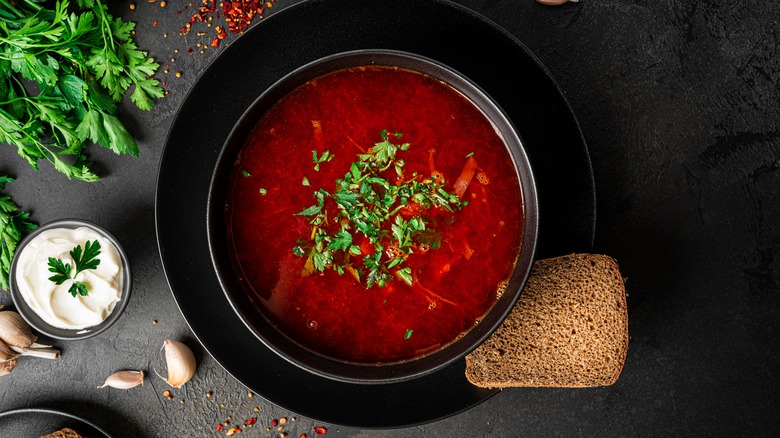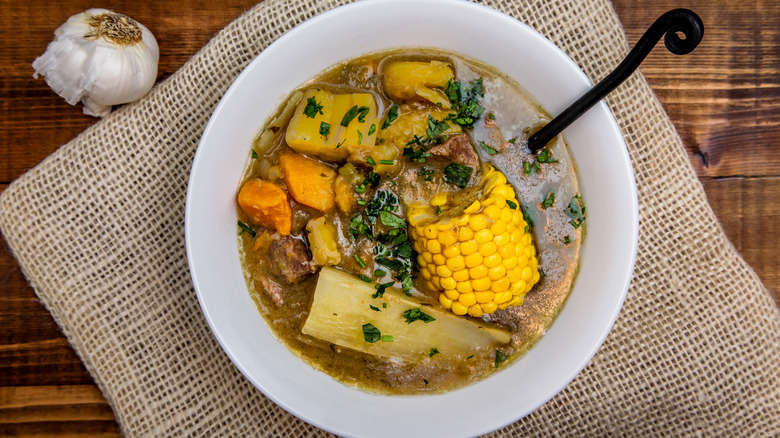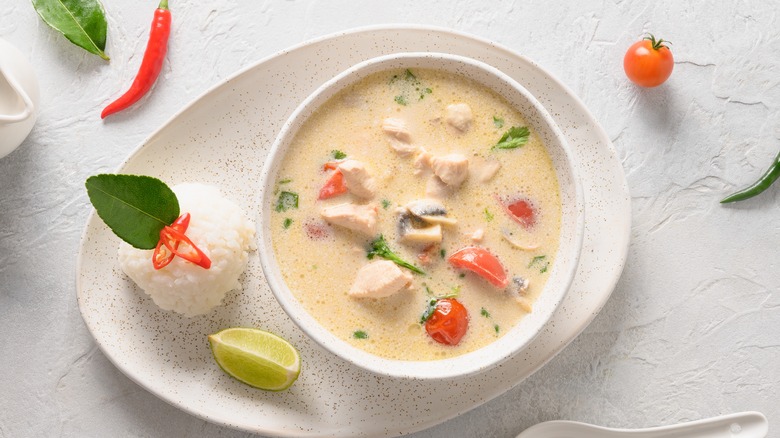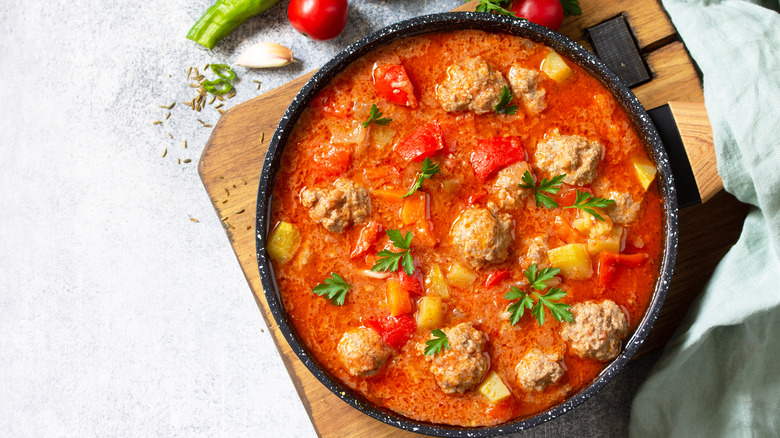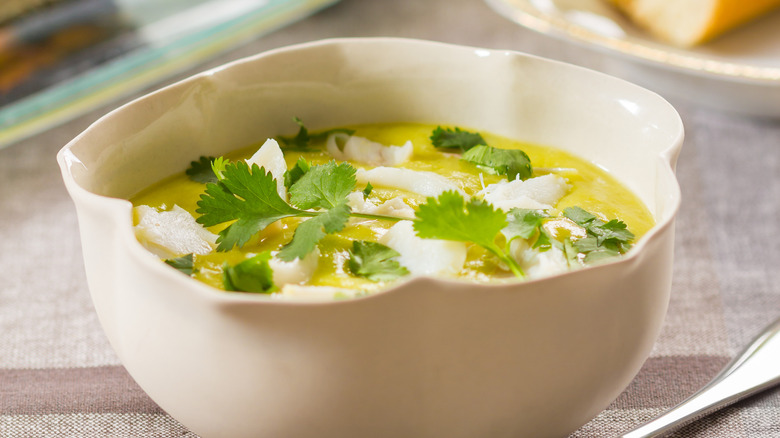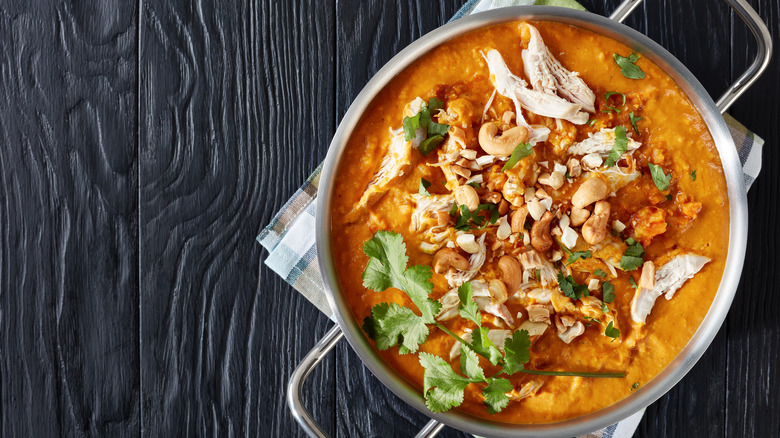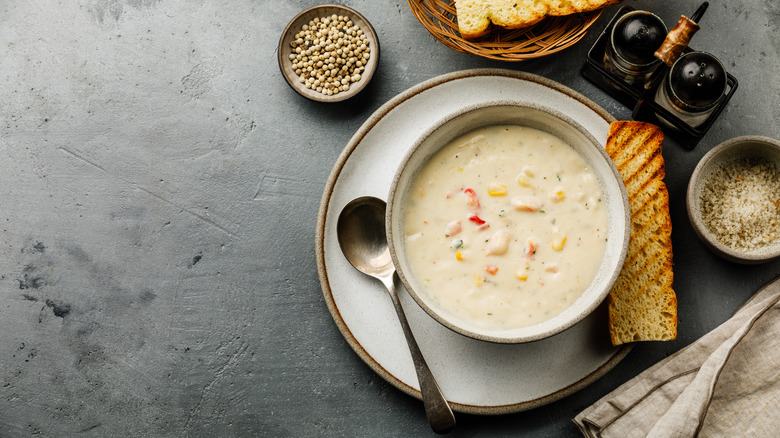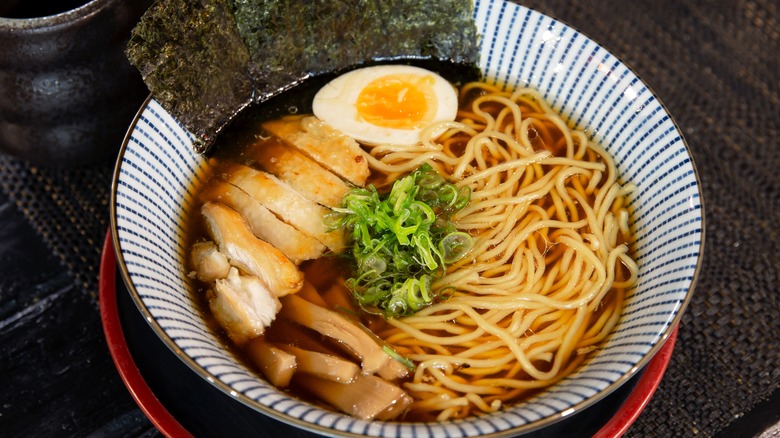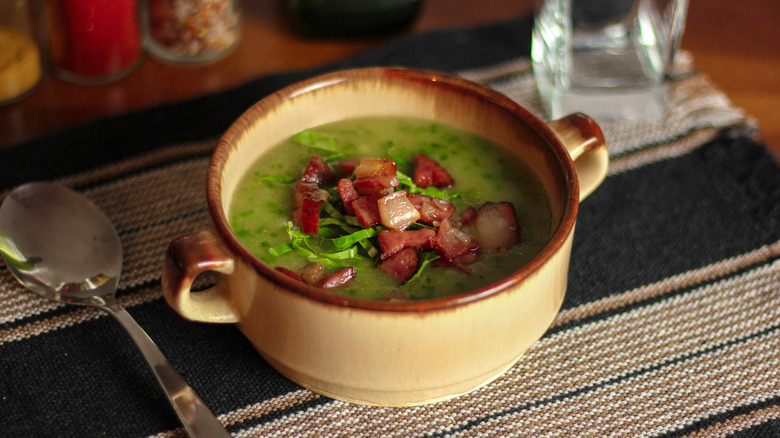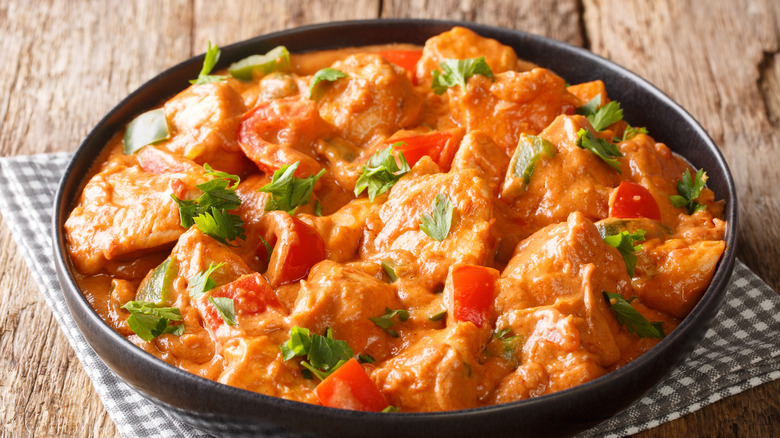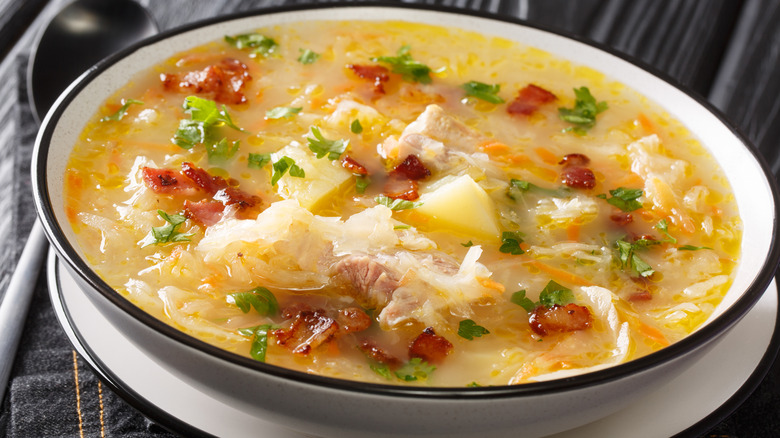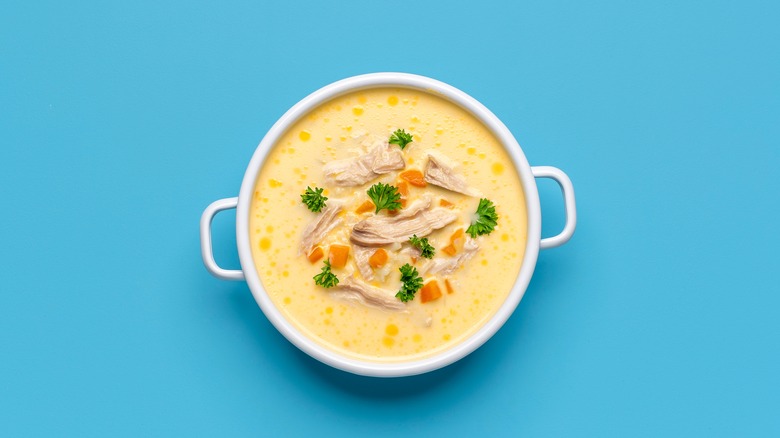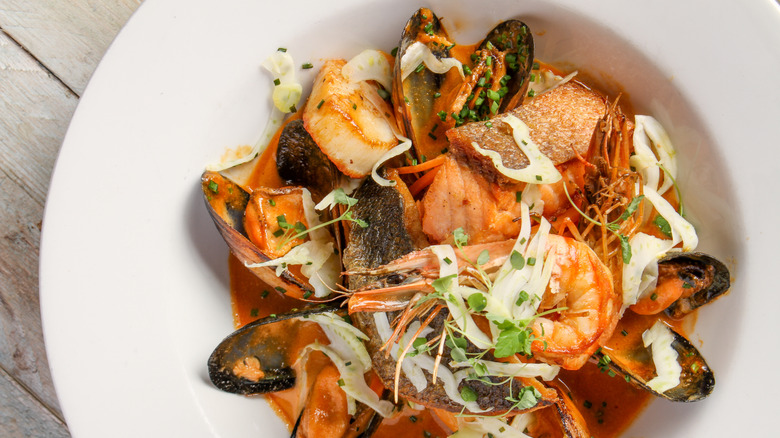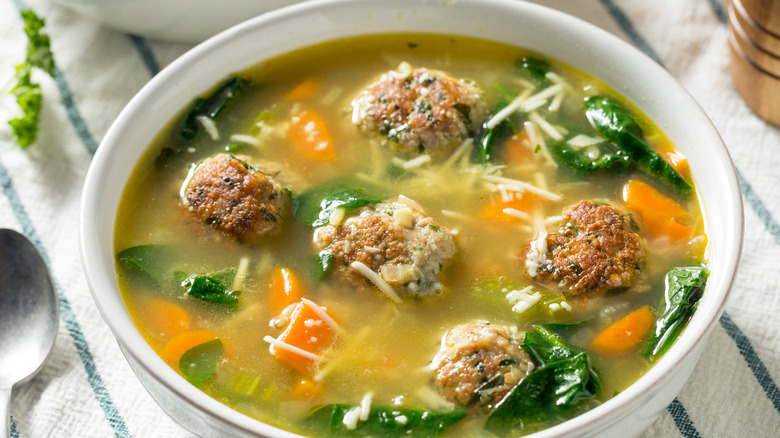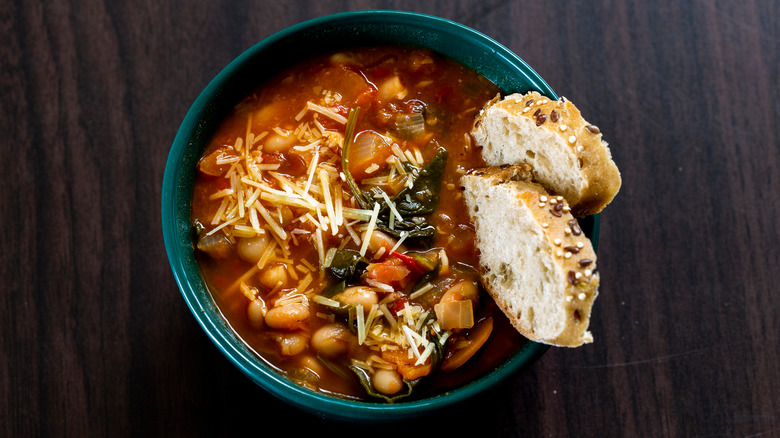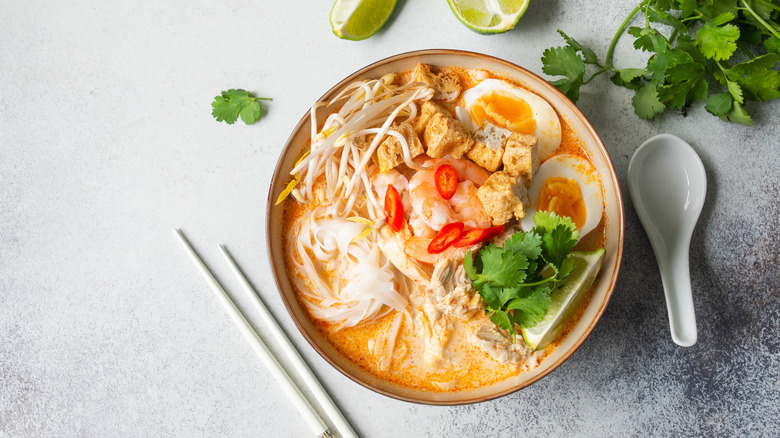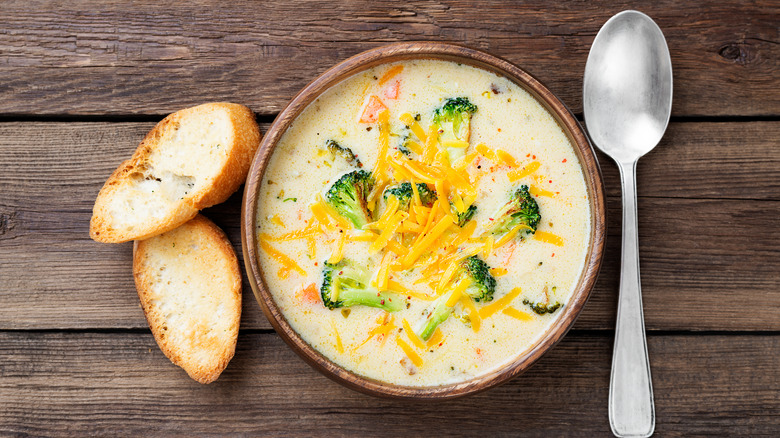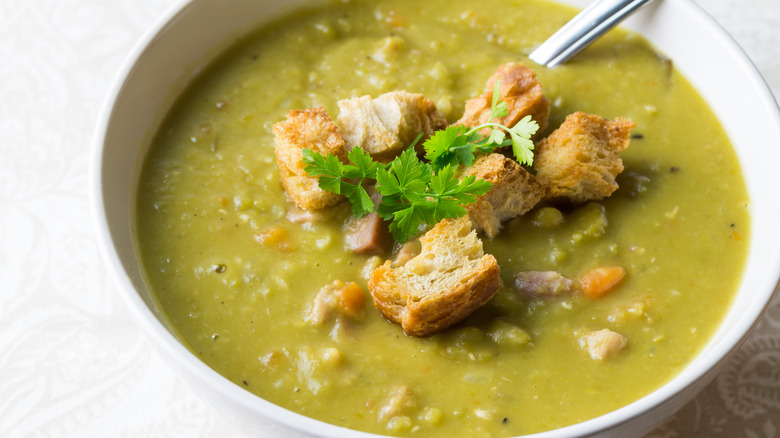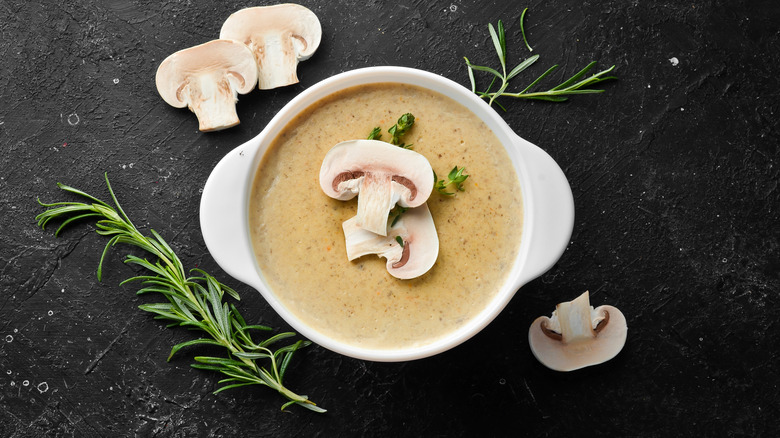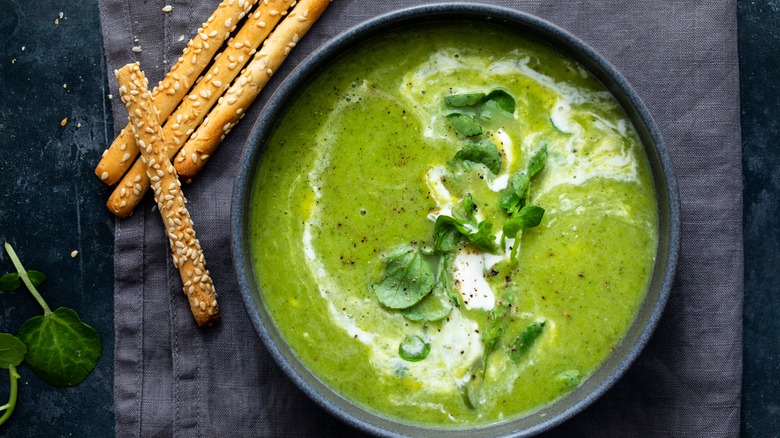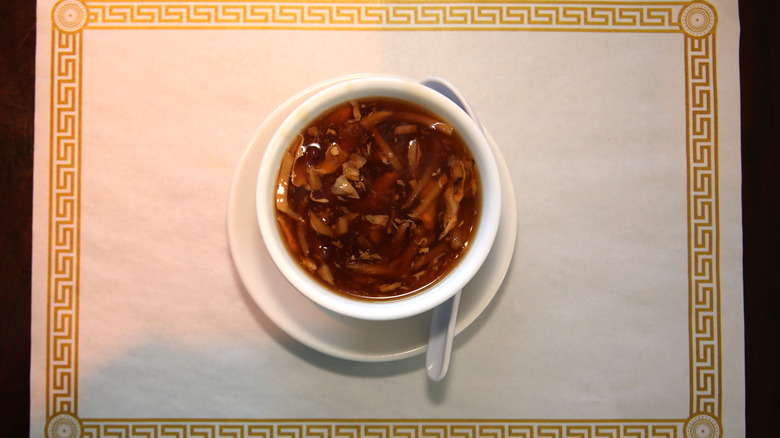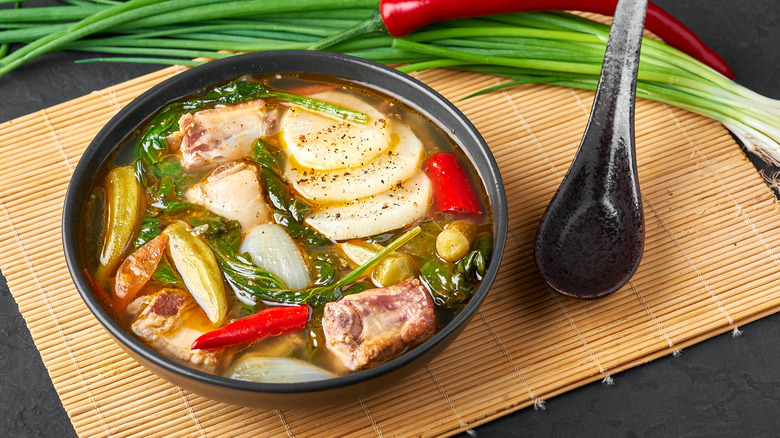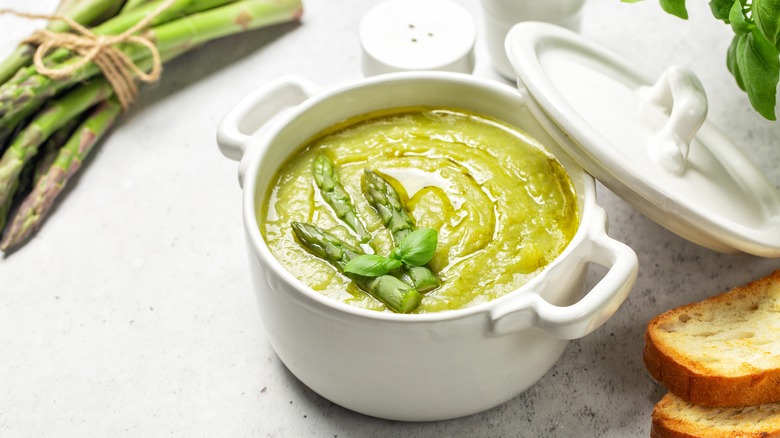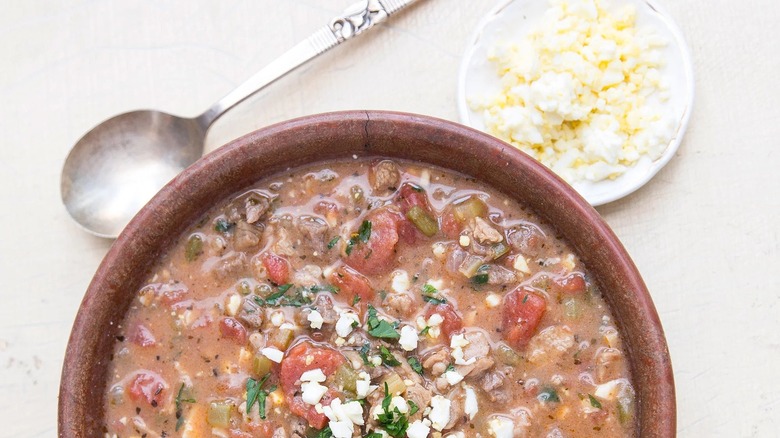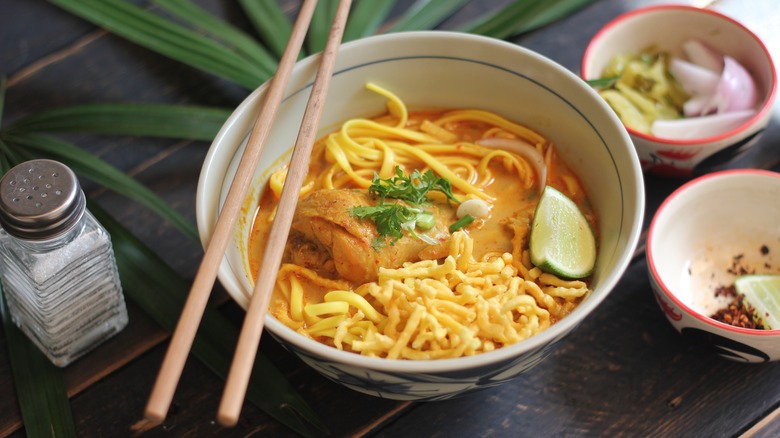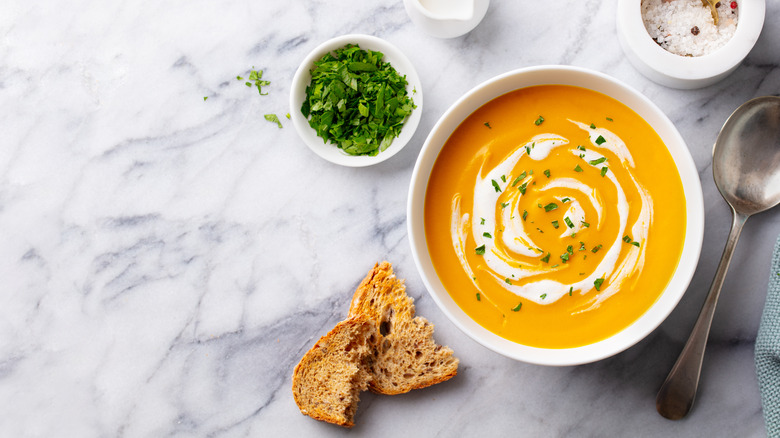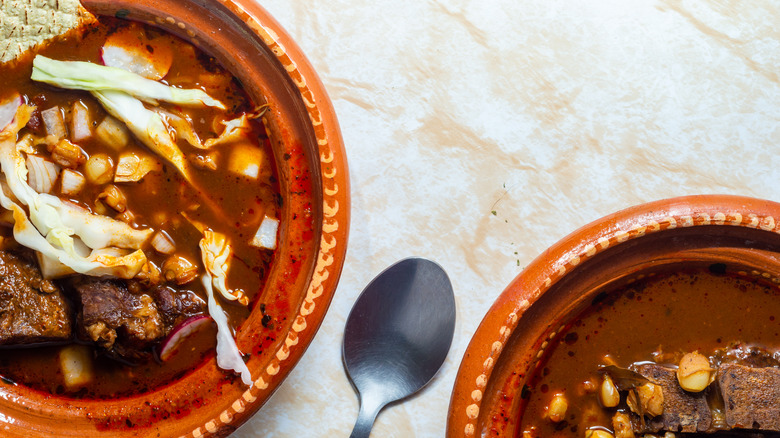40 Types Of Soup And What Makes Them Unique
Amazingly, humans have been eating soup since the Stone Age. Since the first early humans put animal bones and foraged vegetables in a pot with water and set it over the fire, thousands of soups have emerged from around the world featuring unique ingredients and cooking styles. A soup can be a simple arrangement of a handful of ingredients or a complicated affair with hours of simmering and a dozen toppings. Some soups are smooth and pureed, some are chunky, while others are studded with dumplings or long ribbons of noodles.
We rounded up forty of some of the most well-known soups from around the world to show the vast diversity in this food category. From Tennessee to Thailand, hopefully, at least one soup on this list will be enough to whet your curiosity or appetite. Read on to tour the dynamic world of soup.
Pho
No matter how hot the weather, Vietnamese and lovers of Vietnamese cuisine line up to get their hands on a bowl of the beloved soup called pho. This soup consists of rice noodles in a spiced broth and topped with thinly sliced meat, often beef, fresh herbs, chili, and lime. According to the BBC, the specific ingredients and toppings for pho can differ throughout the region of Vietnam. In any iteration, the key is in the broth, like this version by Charles Phan that uses beef neck, shank, and marrow bones.
Chicken noodle
While there are many variations to this homey American soup, the classic version has pieces of chicken, cooked pasta noodles, and chunks of soft carrot in a rich chicken broth. Sometimes, flecks of parsley are added for color. The shape or type of noodle can vary, though it's most often a shorter noodle that can fit on a spoon. While you could make your broth, recipes using store-bought broth like this ultimate chicken noodle soup recipe can also be delicious.
Wonton
Wontons have been a staple food in China for over two thousand years. For nearly as long as wontons have existed, the Chinese have been making a simple soup using the dumplings simmered in a light, clear broth. Sometimes, sliced green onions and other veggies, like bok choy, can be added as well. While the entire dish can be made from scratch, an easy version can also be made using store-bought wontons and broth.
Vichyssoise
A simple soup with a funny name, vichyssoise may sound fancy but is really just a chilled potato and leek soup. The chilled soup dates back to only 1917 when it was first served at the Ritz-Carlton based on a memory from the chef's childhood. Of course, there's no requirement to eat this soup chilled or at room temperature. The base soup is made by first simmering leeks and potatoes in broth before blending and adding cream. For a variation meant to be eaten hot, try the classic potato and leek soup.
Gazpacho
In the world of cold soups, only a few are tasty enough to have spread in popularity throughout the world. Originating in Spain, gazpacho is a chilled, uncooked, pureed soup consisting of tomatoes, peppers, garlic, vinegar, and sometimes thickened with bread or bread crumbs. Some people think of it as a blended salad. Gazpacho can also be adapted and the tomatoes swapped for things like melon, strawberries, or cucumbers. Once you know the basic gazpacho ratio, you can feel free to adjust the flavors to your liking.
French onion
Leave it to the French to take one of the world's most humble ingredients and turn it into a decadent and rich soup that's more than just the sum of its parts. French onion soup is beloved the world over, and it's easy to see why. Deeply caramelized onions are simmered in beef broth for hours until the onions have practically melted. Easy French onion soup recipes call for just a handful of simple ingredients, but more classic recipes exist that use thyme, Cognac, and veal stock.
Either way, the soup is finished by topping it with a thick slice of country bread and a generous shower of Swiss or Gruyere cheese and quickly browning it in the oven or under a broiler. The bread soaks up some of the soup and falls apart with delicious cheesy, oniony goodness in each bite.
Matzo ball
In Jewish culture, a traditional unleavened bread called matzo gets eaten each year on Passover to remember the plight of the Jews who had to leave their homeland so fast they did not have time for their bread to rise. Matzo, and the matzo meal made from crushing it, has been made into all kinds of classic Jewish dishes, notably matzo ball soup. Onions, celery, carrots, and bits of chicken get simmered in a rich chicken broth, along with the matzo ball, a sort of dumpling made from matzo meal, eggs, and soda water.
Tomato
While Americans can hardly be credited with inventing tomato soup (even though the fruit was first cultivated in the Americas), the soup has become a beloved favorite in the country. The tomato soup that most of us know and love is a simple combination of tomatoes, onions, and water or broth. Certain seasonings are sometimes added, like basil or oregano. After simmering, it's blended until smooth and often (though not required) served with crispy grilled cheese.
Minestrone
The tasty Italian vegetable soup known as minestrone is one of the region's staple soups. Consisting of beans, vegetables, and pasta simmered in a rich tomato broth, this chunky soup dates back to the Roman era. There are many ways to make minestrone, and the exact type of beans and pasta can differ from place to place, depending on what's on hand and the chef's choice. You can make a slow cooker minestrone soup with a few cans of beans and tomatoes and some chopped veggies.
Lobster bisque
While the lobster bisque as we know it today was perfected on the East coast of America, its origins are in coastal regions of France. A bisque is a smooth, cream-based soup often made from shellfish such as lobster or shrimp. Lobster bisque uses the shells to first make a flavorful broth, which then gets fortified with sherry or Cognac and then finished with cream. Some lobster bisques also include chunks of lobster meat, while others are smooth.
Miso
Even people unfamiliar with Japanese cuisine are probably aware of miso soup, one of Japan's most prolific culinary exports. It consists of a simple broth, or dashi, traditionally made by simmering miso paste in a broth made with bonito flakes and dried kombu, a type of seaweed. That broth is also sometimes seasoned with soy sauce and spring onions and then studded with soft chunks of tofu. Simple miso soup versions involve using store-bought vegetable broth and simply dissolving the miso paste in the broth if bonito flakes and kombu are hard to find.
Kimchi jjigae
Even though there are dozens of wonderful Korean soups, one of the most well-known around the world is kimchi jjigae. Jjigae refers to a thicker type of Korean soup studded with bites of tofu, meat, or vegetables. In the case of kimchi jjigae, kimchi that has been fermenting and may be at risk of going past its prime can be used up by simmering in a flavorful broth to make kimchi jjigae.
Tortilla
Many soups worldwide use some kind of old bread as a thickener, and tortilla soup is no different. Originating in Mexico, specifically cooler regions near the capital city, tortilla soup is a tomato and chili-based soup thickened with grounded tortillas. Sometimes, bits of chicken, beans, avocado, and cheese are added. Tortilla soup is often topped with crunchy fried tortillas strips, cilantro, and fresh lime. There are many authentic versions of the recipe out there, as well as an easy Instant Pot chicken tortilla soup that captures the essence of this classic soup.
Borscht
Love them or hate them, beets are a staple crop in much of Eastern Europe. Borscht is the name given to the beet soup originating from the Slavic region, though many historians believe it to be Ukraine, specifically. This tart and tangy soup is made by simmering beef and beets, along with other vegetables. It can be eaten either hot or cold and is often served with a dollop of sour cream on top.
Sancocho
One of the more famous soups to come from South America, sancocho is a rich combination of vegetables simmered with some kind of meat, often chicken, and topped with cilantro, onion, and lime, as a garnish. Families gather around the table on Sundays to share this hearty soup that utilizes whatever vegetables are on hand to flavor the broth and to eat alongside the meat. The best part is possibly the chunks of corn on the cob that soaks up all the flavors while cooking.
Tom kha gai
In a region where coconut milk is a staple ingredient used widely in the cuisine, a soup made from a broth of coconut milk is hardly a surprise (via ENSEMBL). Tom kha gai, the hot and sour Southeast Asian soup made with coconut milk, chicken, and galangal, is sometimes also flavored with fragrant lemongrass, ginger, garlic, and makrut lime leaf. Vegetables in the soup can vary, but tomatoes, mushrooms, and long green beans are typical ingredients.
Albondigas
Perhaps a derivative of other Mediterranean meatball soups, albondigas is a Mexican meatball soup that can trace its origin back to the days of Spanish colonists. Albondigas typically has a rich broth, sometimes flavored with tomato chunks or puree along with vegetables, and gets seasoned with cilantro and lime. In a pinch, you could use store-bought meatballs, but the best versions of this soup feature tiny meatballs that can fit on the end of a spoon.
Bourride
Bourride is a simple fish stew that hails from the Provence region of France. The base is a simple fish broth thickened with garlic aioli. Into the base goes a few chunks of a firm white fish (like monkfish) along with a few vegetables like potato, leek, onion, and celery, all simmered until soft. To dine like the French, pair this soup with a hunk of crusty bread to scoop up every bit of delicious soup.
Mulligatawny
Mulligatawny represents more than just another soup — this dish also has a rich history. This soup is based on a traditional Indian soup called rasam, which evolved under British colonialism into mulligatawny. According to Serious Eats, while mulligatawny can have meat or be vegetarian, it's the spices from the cumin, coriander, and curry powder, along with the sweetness from the occasional coconut milk and the presence of lentils, that makes the dish what it is.
New England clam chowder
Nothing is as comforting or rib-sticking as a hot, thick bowl of creamy clam chowder on a cold, East Coast day. New England clam chowder is the thick, white, cream-based soup (as opposed to its red Manhattan counterpart) that's practically the official dish of Boston. A classic clam chowder features chopped clams, cream, bacon, and potatoes that get partially pureed to add thickness. Some recipes switch it up with other ingredients, like corn or peppers.
Ramen
Because of the ingenious invention of instant ramen sold in vending machines and convenience stores worldwide, Japanese ramen is one of the most famous soups in the world. While instant ramen consists of a packet of dried noodles and instant broth powder, traditional ramen is such an important dish in Japan that chefs dedicate their lives to perfecting the broth and noodles.
While there are many different versions depending on the region of Japan and the chef cooking it, you can make simple vegan miso ramen at home with dried ramen noodles, mushrooms, miso paste, soy sauce, and vegetable broth.
Caldo verde
Caldo verde refers to the hearty Portuguese soup made with dark, leafy greens, potato, and sausage simmered in a light broth. The finished soup is overwhelmingly green, hence the name, which translates to green soup. Simple is best for this soup, and many Portuguese are adamant that the broth must be made from water instead of something more flavorful like chicken or vegetable broth.
African peanut stew
The West African peanut stew, sometimes known as maafe, Ghanian groundnut stew, or nkate nkawan, is a tasty, protein-filled soup that uses tons of spices and vegetables blended in perfect harmony. The peanut (sometimes called groundnut) was brought to Africa by traders and colonists from South America.
The base of the soup is made from ground peanuts, tomatoes, onions, and spices. Chunks of meat (typically chicken), peppers, and sweet potato, are common additions to the blended base. In America, some cooks use peanut butter to make a quick version of this hearty African stew because it comes already ground.
Cabbage
In some parts of the world, cabbage was one of the few ingredients that could be stored through the long winter months without the need for refrigeration. For that reason, countless versions of cabbage soup have existed for hundreds of years. A classic old-fashioned cabbage soup uses a mix of vegetables, like carrot, onion, celery, and potato, as well as cabbage, all simmered in broth until tender. Some versions also have bits of tomato or chopped bacon for extra flavor.
Avgolemono
The warm climate of the Mediterranean isn't known for creating a wide range of piping hot soups, but one famous Greek soup that has stood the test of time is avgolemono. This lemon and chicken soup is creamy, tangy, and delicious. The base of the soup is not unlike an American chicken soup, except a mixture of lemon and beaten egg is whisked into the soup to create a creamy, smooth texture that's studded with bites of chicken.
Bouillabaisse
The French-born stew known as bouillabaisse is a seafood soup that can use a myriad of oceanic delights along with rich fennel and tomato broth. Traditionally, this soup is made using a combination of seafood that otherwise went unsold by fishermen or restaurants. If you want to make a homemade bouillabaisse, you can grab a few ounces of whatever shellfish is fresh, like mussels, clams, and shrimp, along with some kind of firm fish, like cod or snapper.
Italian wedding
Italian wedding soup is a brothy vegetable soup studded with meatballs or chunks of sausage. There's a rumor that this soup was served to newlyweds on their wedding night to give them energy for the festivities. However, other stories claim that the "wedding" in this soup is simply between the meat and vegetables. Other than meatballs, Italian wedding soup consists of mirepoix (onions, carrots, celery) along with a dark, leafy green like kale or spinach simmered in a clear broth.
Ribollita
In a country where making bread is practically a national pastime, it makes sense there would be recipes created to use up the stale leftovers. Ribollita is a Tuscan vegetable stew that utilizes bread as a thickener. While the other ingredients can vary, ribollita invariably uses kale and white cannellini beans, along with classic aromatics like onions and garlic. Ribollita means re-boiled, as this soup is meant to be reheated multiple times for the best flavor.
Laksa
Some foods are the product of centuries of cultural blending and trade, as evidenced by the combination of flavors and ingredients that people brought from place to place. Singapore was an important trading hub for centuries, and the local cuisine reflects that sentiment, perhaps no dish more than a simple bowl of laksa. Laska is a coconut milk noodle soup commonly served in hawker stalls around Singapore. The type of noodles and exact toppings vary throughout the region, but the broth typically includes fragrant ingredients like lemongrass, galangal, chili, ginger, and lime.
Broccoli cheddar
There's sometimes so satisfying about the combination of broccoli and cheese. Perhaps that's how broccoli cheddar soup became one of the most popular soups, beloved by many all over the world. While many kinds of cream-based vegetables exist, the sharpness of the cheddar sets broccoli cheddar soup apart in terms of flavor and richness. Classic broccoli cheddar soup is a simple affair made by sweating mirepoix with broccoli, then simmering the vegetables in milk and broth before blending and finishing with a generous pile of cheddar cheese.
Split pea
Split pea soups have existed since the Bronze Age, when ancient peoples would extend the life of fresh peas by drying them to be made into hearty soups in the winter. These days, a classic split pea soup is typically made with a smoky ham hock and cubes of ham that simmer while the soup cooks to make a hearty and delicious meal. Other than that, split pea soup uses a few other simple ingredients, like onion, carrot, and celery.
Cream of mushroom
Like other pureed vegetable soups, the provenance of cream of mushroom soup is hardly a mystery. Where people had mushrooms and cream, they had cream of mushroom soup. At its simplest, cream of mushroom soup consists of onions and mushrooms cooked until browned, then simmered in broth and cream. Finally, it gets pureed to a silky-smooth consistency. Canned cream of mushroom soup, once called "America's béchamel," is a staple product and has been used widely as an ingredient in casseroles and other baked dishes for the better part of a century.
Watercress
While some soups are rustic, and others are chic, watercress soup is a bit of both. Utilizing fresh watercress, watercress soup utilizes vegetable or chicken broth along with onions and potatoes to make a vibrantly green dish that is as tasty as it is visually appealing. History credits the English with turning watercress into this flavorful soup, but humans have consumed watercress for at least three thousand years, making this soup one of the oldest in existence.
Hot and sour
A treasured dish from the mountains of China to the takeout containers of American diners, hot and sour soup is a Sichuan dish that's perfect for cold nights. The soup is literally served hot, but it gets its name from the spicy white pepper powder used to flavor it. The sour component is black rice vinegar, a deep and complex staple of Sichuan cooking. In addition, hot and sour soup usually features mushrooms and pork and is sometimes thickened with a whisked egg.
Sinigang
The Filipino soup sinigang is a sour vegetable-based soup that some believe to be one of the world's best. Like many treasured local soups, the exact ingredients can depend on the region or whatever the chef has on hand (like this octopus sinigang served at LASA in Los Angeles). The soup gets its sour flavor from tamarind, a tangy fruit native to Southeast Asia, and the base is often the starchy water created when rinsing rice. Sometimes, Filipinos add meat or fish for a heartier meal.
Asparagus
These days, asparagus is a ubiquitous vegetable available at the grocery store year-round. But a few hundred years ago, it was a special springtime delicacy that could only be enjoyed in winter if grown in a greenhouse. Making an easy cream of asparagus soup is as simple as sweating some onion and garlic, adding vegetable or chicken broth, and simmering asparagus and potato until tender before blending to a smooth consistency. Some recipes call for cream or half-and-half for extra richness.
Turtle soup
While the practice is long outdated, hunting turtles used to be common in the Americas. A classic soup stemming from this practice is turtle soup, a treasured dish for many years and especially popular in the American south. Turtles of all kinds could be used to make the hearty stew, and parties were often thrown with turtle soup as the main event. While turtle is a soup ingredient in many regions around the world, the American version uses a dark brown roux as a thickener and features a myriad of vegetables, not unlike a gumbo.
Khao soi
Another incredible soup from Southeast Asia is khao soi, a Burmese-Thai soup eaten in cooler, northern regions. This soup features coconut milk simmered with fragrant curry paste. Before serving, a generous portion of yellow Chinese egg noodles is added to the soup. The term khao soi actually translates to "cut rice," a direct reference to the original recipe use of rice noodles. Most versions include chicken and a hearty assortment of delicious toppings like cilantro sprigs, chili oil, and fresh lime.
Butternut squash
When the weather gets cooler, an enduring and perennial classic is butternut squash soup. The tough-skinned squash transforms into a silky-smooth soup once roasted and pureed. Some versions use a bit of cream, and others do not. Most use onions, leeks, garlic, and sometimes carrots, along with the squash, for extra depth of flavor. This easy roasted butternut squash soup uses brown butter and fresh sage to take it to the next level.
Posole
One of Mexico's most loved soups is posole (sometimes spelled pozole), no matter what the season. This hearty soup uses pork, along with onions, garlic, peppers, and spices to create a rich broth. Posole also features a special ingredient: hominy. Hominy refers to whole kernels of corn that have been nixtamalized, a special process that dates back to pre-Spanish colonial Mexico. Posole can be red or green, depending on the peppers used to create the base.
